|
The Human Cell: the miracle of life
All living things whether plant or animal
are constructed from discrete blocks called cells. Each cell is a self-ecapsulated, specialised unit capable a
predetermined set of programmed functions, and in most instances - self-replication. In many ways, the cell is
perfoming the amazing act of organised and purposeful molecule orchestration. It is the smallest unit of complete
life and regins at the 'living' side of the boundary which divides organic living entities from non-living ones.
Since there are quite a few 3D models
in existence to help illustrate the internal structure of individual human cells, I thought an article about cells
would be of interest to light microscopists and biology students alike - especially as we only get to see them
as stained, flat, one-dimensional objects. I think that an in-depth discussion of each cell, is far too specialised
an area for me to cover
here, but hopefully I can point out a few things of interest. Possibly, seeing the cells as 3D objects close-up,
will also provide greater insight into what can only be described as the miracle of life.
A Generic Human Cell
Each cell in the human
body (and animals) is specialised but most will contain structures and processes common to all. Fig. 1 below, which
has been derived from an inexpensive 3D model, clearly shows some of the more important processes. A brief explanation
of the function of each of these follow Fig 1.
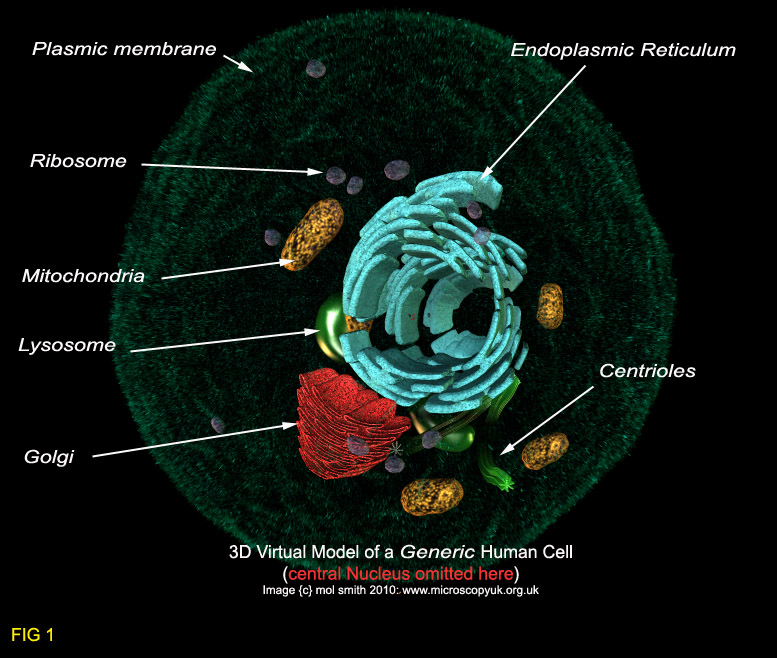
Plasmic Membrane
This is the cell surface
membrane, completely encasing all internal processes. Made of two layers of lipid (bilayer) sandwiched between
two protein layers, it forms a partially permeable barrier - controlling exchanges (gas) between the cell and the
exterior environment. Numerous proteins are also present in the membrane acting as sensors for taste and hormones,
as are tiny pores to control the essential entry and exit of irons, e.g. chloride, sodium, potassium, and calcium.
Endoplasmic Reticulum
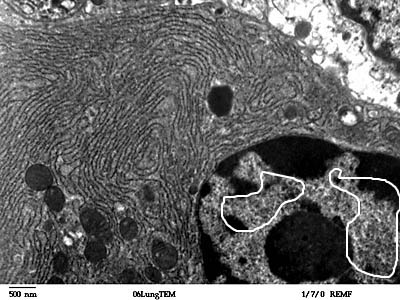
Image is from Wiki
This file has been (or is hereby) released
into the public
domain by its author, Louisa Howard. |
There are two types of Endoplasmic
Reticulum: rough and smooth - the former, so called because of the presence of ribosomes on its surface, displaying
a 'pebbled' surface in a scanning electron microscope image. Both types are flattened membrane-bounded sacs called
cisternae. The 'smooth' type is the site of lipid and steroid synthesis. The 'rough' ER (ribosomes on surface)
transports ribosomes through the cisternae.
A tunnelling electron image of a section of lung can be seen on the left. The area of rough endoplasmic reticulum
network is around the nucleus (shown in lower right-hand side of the picture and circled in a white line by me).
Dark small circles in the network are mitochondria.
The discovery of Endoplasmic Reticulum was only through the use of an electron microscope as the pattern (both
rough and smooth) and beyond the resolving power of an optical microscope.. |
Ribosomes
These small organelles,
consisting of a large and a small submit, are made of RNA and proteins in approximate equal parts. They are the
site of protein synthesis, holding in place various interacting molecules. Long
protein chains are formed at the the intersection of the large and small submit.
Mitochondria
The fuel-cell of living
cells, mitochondria combine sugar and Oxygen to provide ATP (Adenosine triphosphate *wiki) - the power source for living entities. They
are about the size of an average-sized bacterium.
The number per cell varies depending on the nature of the cell. So, for example, cells requiring hig energy quanta
lilke liver cells possess more than 1000 mitochondria, wereas many less active cells will have far fewer. Their
shape may be spiral, sphereical, elongate, cup-shaped, or branched. They can also change shape! Some are even able
to moved to more active areas within a cell by a process called cytoplasmic streamimg.This aids the cell by providing
larger quantity of ATP at sites where it is most required.
Mitochondria
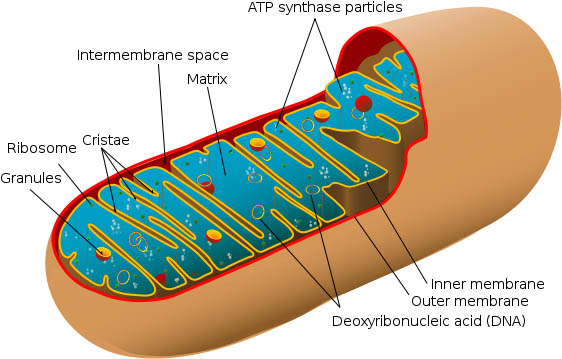
Image Author: Mariana Ruiz Villarreal
Ladyofhats Image
published on Wiki Image has been released into the Public Domain
Each mitochondrion is bounded by two membranes (like an envelope) with the inner and outer sheets approx 8nm apart.
Little knowledge exists concerning the outer membrane. It is thought the outer membrane contains a large number
of big transport proteins - allowing large molecules to enter the membrane with ease. It is thought to be permeable
to substances with molecular weights less than 21,000 - allowing them to diffuse across it. The space between the membranes contains enzymes that use ATP to phosphorylate other nucleotides.
The Inner Membrane exhibits selectivity
over what materials are allowed through it. The membrane is highly convoluted, forming many folds called cristae.
This serves to greatly increase the surface area, serving to provide abundant space for multi-enzyme systems. It
contains three major proteins: ones that carry out the oxidation reactions of the respiratory chain; some which
are 2. enzyme complexes called ATP synthetase which makes ATP, and finally - transport proteins. These are responsible
for regulating the transfer of molecules into and out of the matrix - an area of the mitochondria where the oxidation
phosphorylation takes place, and where several copies of the mitochondrial DNA genome, robosomes, tRNAs, are stored.
(see diagram above).
Lysosomes
These are simple spherical membranous
sacs containing digestive hydrolytic enzymes, and they are concerned with breaking down structures of macromolecules.
The lysosome contains over 40 enzymes, some of which are the proteases, nucleases, and phopholipases.These enzymes
are called hydrolases, and are made in the Endoplasmic Reticulum then transported to the lysosome by the Golgi
complex, using a vesicle. If certain hydrolases are missing from the cells, a situation will occur where there
is a build-up of macromolecules which cannot be digested ny the lysosome. These superflorous molecules will interfere
with normal cell function and lead to serious illness. Lysosomes, although found in all human cells, are more abundant
in white blood cells because white blood cells must digest more material than most other types of cells in their
quest to battle bacteria, viruses, and other foreign intruders.
Golgi
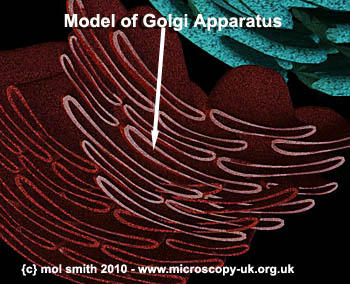 |
The Golgi apparatus was discovered
by Camillo Golgi in 1898 using special staining techniques, but its structure was only revealed over forty years
later by an electron microscope.
Commonly called the Golgi Apparatus, this stack of flattened membrane-bound sacs (cisternae) coated with lipid
membranes and ressembling a pile of plates, continuously forms at one end of the stack and buds off as vesicles
at the other. These vesicles are used to send molecules to the cellular membrane, where they are excreted. There
are also larger secretory vesicles, which are used for selective excretion. |
Centrioles
These are small hollow
cylinders (0.3Ám - 0.5Ám long) which occur in pairs within the cell cytoplasm (originating in an area
called the centrosome). Each tube is constructed of 9 triplets of microtubules, and is thought that adjacent triplets
may be attached to each other by fibrils. The centrioles replicate themselves at the beginning of nuclear division,
and the two new pairs migrate to opposite ends of the spindle: the structure on which the chromosomes become aligned. |
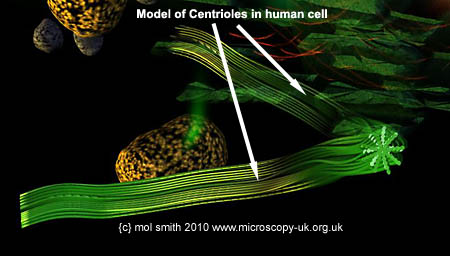
|
The diagram below shows
a generic human cell cut-away to reveal the internal processes described above. this diagram should help you relate
the cell components to my 3d model image above.
Please note: the diagram
was authored by MesserWoland and Szczepan1990 15 October 2006(2006-10-15), created with Inkscape, based on the
graphics from en wiki. http://en.wikipedia.org/wiki/File:Biological_cell.svg
Permission: (Reusing this file) copyright Multi-license with GFDL and Creative Commons CC-BY-SA-2.5 and older versions
(2.0 and 1.0)
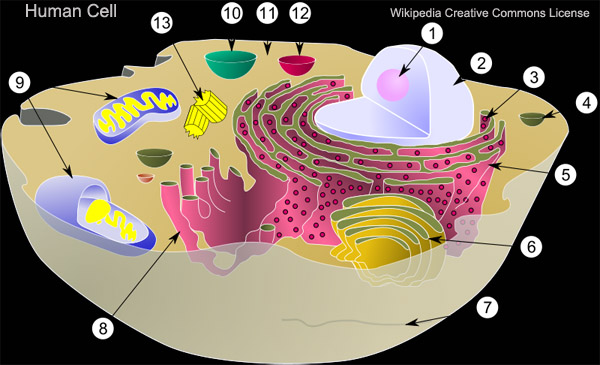
Diagram of a typical animal cell. Click on *wiki next to label below for description.
Organelles are labelled as follows:
1 -Nucleolus *wiki
2 -Nucleus *wiki
3 -Ribosome *wiki
4 -Vesicle *wiki
5 -Rough endoplasmic reticulum *wiki
6 -Golgi apparatus (or "Golgi body") *wiki
7 -Cytoskeleton *wiki
8 -Smooth endoplasmic reticulum *wiki
9 -Mitochondrion *wiki
10 -Vacuole *wiki
11 -Cytosol *wiki
12 -Lysosome *wiki
13 -Centriole *wiki
The Cell Nucleus
I have omitted the cell
nucleus from my model image above for reasons of clarity. The image below shows a cut-away model representation
of the Cell Nucleus. Note:
I have made the nucleus membranes semi-transparrent so you can peer inside the nucleus itself!
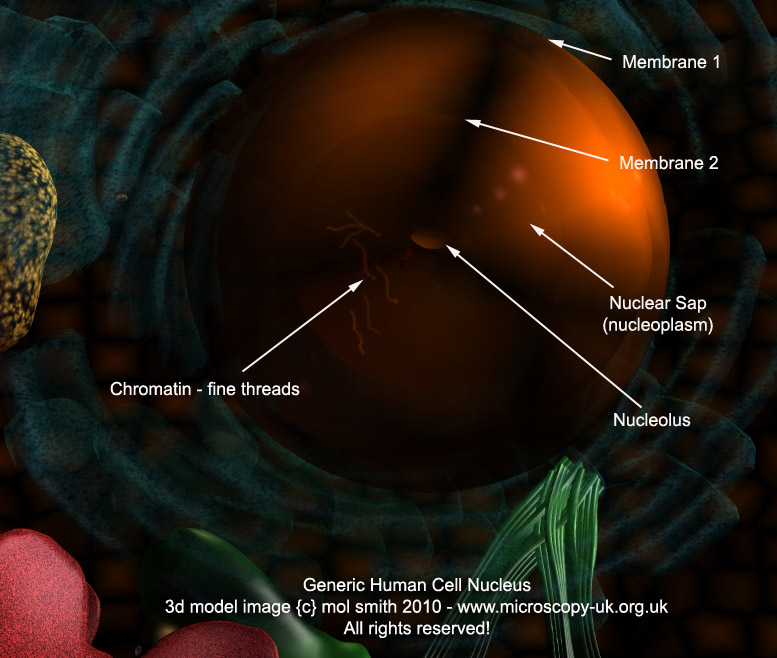
The Nucleus is the largest organelle found with
within human eukaryotic cells. It is enclosed by an envelope of two membranes which are perforated by nuclear pores
(not visible in the model above). It contains chromatin - an extended form of chromosomes during interphase, and
a nucleolus, which manufactures RNA. Nuclear transport is critical to healthy cell function, as movement through
the pores is needed for gene expression and chromosomal maintenance. Pores, within the nuclear membrane, provide
channels for the movement of irons and small molecules through it, whereas the control of movement of large molecules
- like proteins - is strictly controlled and regulated by carrier proteins within the cell.
Phagocytosis and endocytosis: the cell
membrane pinches together, forming an intracellular membrane-bound compartment, called a phagosome or endosome,
that contains extracellular material. The phagosome travels from the cell membrane to the nucleus, and then is
engulfed by the nucleus, releasing its contents. (see image beneath).
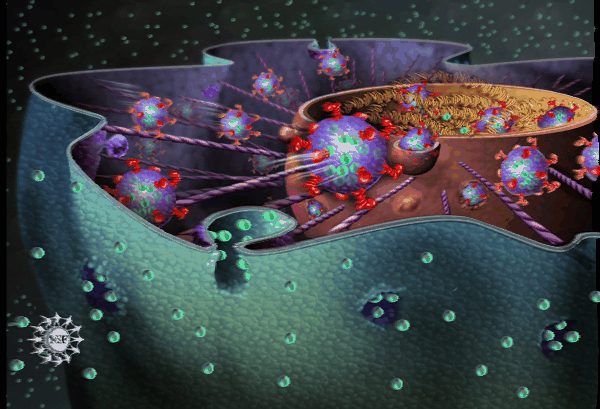
cell nucleus - original
2d image - wiki
- public domain - author: United States Federal Government
This 3d transformation is mol smith 2010 - I have put this 3d version into the public domain.
Please quote: www.microscopy-uk.org in any credits of re-use.
Life Span of Human Cells
It is interesting to
note that with the exception of most (not all) cells of the brain, your entire body, and what constitutes it, is
completely replaced a number of times throughout your life-time. Cells throughout the body continue to renew themselves
by a process of replication. This is done at a different rate depending on the life-span of the cell type. The
brain is the only organ where this process of replication does not occur (except for the cells - neurons - in the
hippocampus). Fortunately, although the number of neurons within the brain begin to decline due to cell death from
around the age of 28 years, it is hardly noticed until our very late years due to the presence of around 100 billion
Neurons at birth.
Here is a list of some of the cell life-spans of the human body
Sperm cells 2-3 days
Epithelia of small intestine 1 week or less
Skin epidermal cells 2 - 4 weeks
Lymphocytes 2 months - a year (highly variable)
Red blood cells 4 months
For a more comprehensive
list, please visit: http://vitanetonline.com/forums/1/Thread/1001
Movies
Here is a tiny animated movie I made showing the generic
human cell spinning.
Note: this is a movie.
Please wait for it to load fully!
|